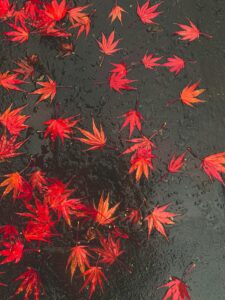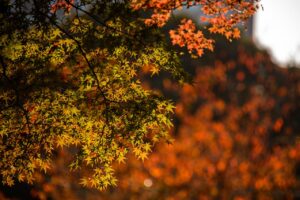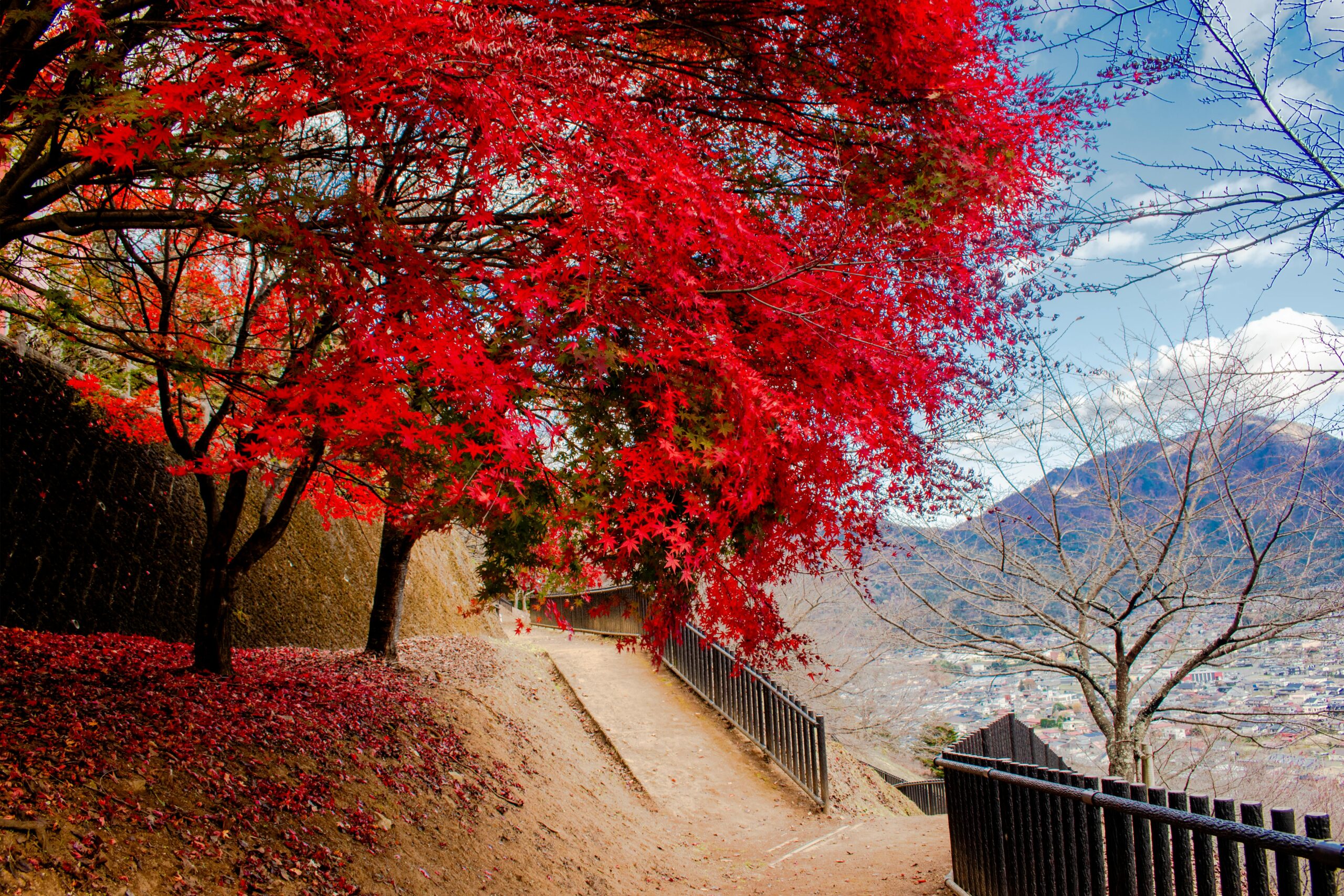When autumn arrives in Japan, the air becomes crisp, the skies turn clear, and the landscapes burst into brilliant shades of red, orange, and gold. This breathtaking display of nature is called “Momiji” (紅葉)—a word that specifically refers to Japanese maple leaves and, more broadly, to the changing colors of fall foliage. For centuries, Japanese people have celebrated the beauty of autumn leaves through a seasonal tradition known as momiji-gari (紅葉狩り), or “autumn leaf hunting.”
Just like cherry blossoms in spring, autumn leaves in Japan are more than just beautiful scenery—they’re part of the rhythm of life, influencing seasonal foods, festivals, and even the snacks you’ll find in your local convenience store. Let’s explore how Japan celebrates momiji season and how this natural beauty connects with comforting fall flavors like chestnuts, mushrooms, and maple-shaped sweets.
🌿 The Tradition of Momiji-Gari

Momiji Gari Freedom Japanese Market
The word “momiji-gari” literally means “hunting autumn leaves,” but it’s less about gathering and more about appreciating the beauty of nature. Families, friends, and couples take trips to mountains, parks, and temples to view the leaves at their peak. The tradition dates back over 1,000 years, appearing in classical Japanese poetry and literature from the Heian period.
Popular momiji-gari spots include:
- Kyoto’s templessuch as Kiyomizu-dera and Tofuku-ji, where fiery red maples glow against wooden halls and stone gardens.
- Nikko in Tochigi Prefecture, famous for its waterfalls surrounded by golden foliage.
- Arashiyama’s riversidein western Kyoto, where the blend of colorful trees and traditional boats creates postcard-perfect views.
For Japanese people, momiji season is a time to slow down, take photos, and share in the beauty of fleeting moments—an idea deeply rooted in the cultural value of mono no aware, the gentle awareness of impermanence.
🍂 Seasonal Foods Inspired by Momiji
Autumn in Japan isn’t just about the sights—it’s also about the flavors. The harvest season brings comforting, earthy foods that match the mood of the cool weather. Many of these foods are directly linked with momiji, either in appearance or symbolism.
🌰 Chestnuts (Kuri)
Chestnuts are one of the stars of Japanese autumn cuisine. You’ll find them in everything from roasted street snacks to kuri gohan (chestnut rice) and elegant chestnut desserts. One famous sweet is Mont Blanc cake, which layers chestnut cream on top of sponge cake—a perfect match for autumn tea time. Chestnuts represent abundance and comfort, making them a seasonal favorite.
🍄 Mushrooms (Kinoko)
Mushrooms are another autumn essential, especially varieties like shiitake, maitake, and matsutake. Matsutake mushrooms are highly prized for their rich, woody fragrance and are often served simply grilled or in soups. Mushroom flavors also inspire popular snacks, like Meiji’s Kinoko no Yama, where crispy biscuits are topped with chocolate caps in the shape of tiny mushrooms.
🍁 Maple-Shaped Sweets
Perhaps the most iconic autumn treat is the momiji manju, a maple leaf-shaped cake filled with sweet red bean paste. This specialty of Hiroshima Prefecture perfectly symbolizes the season: the outside resembles the beauty of momiji leaves, while the inside offers the cozy sweetness that Japanese people associate with autumn gatherings.
Other seasonal wagashi (traditional sweets) also take inspiration from nature, with designs shaped like golden ginkgo leaves, persimmons, or chestnuts. These sweets aren’t just snacks—they’re edible works of art celebrating the season.
🧺 Momiji-Gari and Food Go Hand in Hand
One of the best parts of momiji-gari is enjoying food outdoors while taking in the scenery. People often bring bento boxes filled with rice, seasonal vegetables, and grilled fish. In some regions, you can also find momiji tempura, where maple leaves are lightly battered and fried into a crisp autumn snack.
Seasonal drinks also make their appearance, such as sweet potato lattes, roasted green tea (houjicha), or limited-edition pumpkin and chestnut sweets at coffee shops. Convenience stores and supermarkets launch autumn-themed products every year, from purple sweet potato Kit Kats to maple-flavored gummies, making it easy for anyone to join in the seasonal fun.
🌏 Why Momiji Season Captures the World’s Attention
Just as Japan’s cherry blossom season has become world-famous, momiji season is drawing more and more international visitors. Tourists plan their trips around “koyo front” maps, which track when the leaves will change color across the country. From Hokkaido’s early October display to Kyushu’s late November glow, the season can last nearly two months if you travel southward.
For people outside Japan, momiji season feels magical because it combines natural beauty, cultural traditions, and seasonal foods into one harmonious experience. Even if you can’t travel to Japan, tasting autumn snacks and learning about these customs can make you feel connected to this beautiful season.
🍁 Momiji in Everyday Life

Beyond festivals and tourism, momiji also finds its way into everyday Japanese life during autumn:
- Decorations: Restaurants and shops display maple leaf ornaments or use momiji motifs in packaging.
- Fashion: Seasonal kimono patterns often feature autumn leaves, symbolizing elegance and the passage of time.
- Language: In Japanese conversation, people often exchange greetings about the beauty of the season, just as they do in spring with cherry blossoms.
This seasonal awareness shows how deeply nature is woven into Japanese culture, influencing not just what people eat, but also how they live and communicate.
🥢 Experience Momiji Season Through Snacks
At Freedom Japanese Market, we love celebrating Japan’s seasons through food. Autumn is especially fun because of the cozy, comforting flavors that match the beauty of momiji.
By tasting these seasonal treats, you’re not only enjoying delicious flavors—you’re also experiencing a piece of Japanese culture, the same way families in Japan do during their autumn outings.
🌸 Final Thoughts
Momiji season in Japan is more than a change in scenery—it’s a celebration of life’s fleeting beauty, captured through nature, traditions, and seasonal foods. From the simple joy of walking under fiery maple trees to savoring chestnut rice or maple-shaped cakes, autumn in Japan invites you to slow down and embrace the warmth of the season.
Whether you’re traveling in Japan or enjoying snacks at home, momiji reminds us that every season has its own charm—and every flavor its own story.
👉 Want to bring a taste of momiji season to your home? Join us at Freedom Japanese Market and discover Japanese snacks that capture the beauty of every season.

